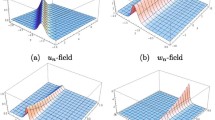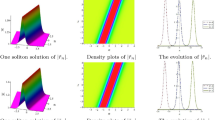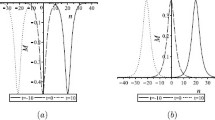Abstract
In this paper, we derive the Grammian determinant solutions to the modified two-dimensional Toda lattice, and then we construct the modified two-dimensional Toda lattice with self-consistent sources via the source generation procedure. We show the integrability of the modified two-dimensional Toda lattice with self-consistent sources by presenting its Casoratian and Grammian structure of the N-soliton solution. It is also demonstrated that the commutativity between the source generation procedure and Bäcklund transformation is valid for the two-dimensional Toda lattice.
Similar content being viewed by others
1 Introduction
The two-dimensional Toda lattice, which can be regarded as a spatial discretization of the KP equation, takes the following form:
where \(V_{n}\) denotes \(V(n,x,s)\). We use the above notation throughout the paper. Under the dependent variable transformation
equation (1) is transformed into the bilinear form [1, 2]:
where the bilinear operators are defined by [2]
It is shown in [2, 3] that the two-dimensional Toda lattice equation possesses the following bilinear Bäcklund transformation:
where λ, μ, ν are arbitrary constants. Equations (4)-(5) are transformed into the following nonlinear form:
through the dependent variable transformation \(u_{n}=\frac{\partial}{ \partial s}\ln(\frac{f_{n}}{f'_{n}})\), \(v_{n}=-\frac{\partial}{\partial x}\ln(\frac{f_{n}}{f'_{n-1}})\). Equations (4)-(5) or (6)-(7) are called the modified two-dimensional Toda lattice [2, 3]. The solutions \(V_{n}\) of the two-dimensional Toda lattice (1) and \(u_{n}\), \(v_{n}\) of the modified two-dimensional Toda lattice (6)-(7) are connected through a Miura transformation [2].
The soliton equations with self-consistent sources can model a lot of important physical processes. For example, the KdV equation with self-consistent sources describes the interaction of long and short capillary-gravity waves [4]. The KP equation with self-consistent sources describes the interaction of a long wave with a short-wave packet propagating on the \(x,y\) plane at an angle to each other [5, 6]. Since the pioneering work of Mel’nikov [7], lots of soliton equations with self-consistent sources have been studied via inverse scattering methods [7–11], Darboux transformation methods [12–17], Hirota’s bilinear method and the Wronskian technique [18–24].
In [25], a new algebraic method, called the source generation procedure, is proposed to construct and solve the soliton equations with self-consistent sources both in continuous and discrete cases. The source generation procedure has been successfully applied to many \((2+1)\)-dimensional continuous and discrete soliton equations such as the Ishimori-I equation [26], the semi-discrete Toda equation [27], the modified discrete KP equation [28], and others. The purpose of this paper is to construct the modified two-dimensional Toda lattice with self-consistent sources via the source generation procedure and clarify the determinant structure of N-soliton solution for the modified two-dimensional Toda lattice with self-consistent sources.
The paper is organized as follows. In Section 2, we derive the Grammian solution to the modified two-dimensional Toda lattice equation and then construct the two-dimensional Toda lattice equations with self-consistent sources. In Section 3, the Casoratian formulation of N-soliton solution for the modified two-dimensional Toda lattice with self-consistent is given. Section 4 is devoted to showing that the commutativity of the source generation procedure and Bäcklund transformation is valid for two-dimensional Toda lattice. We end this paper with a conclusion and discussion in Section 5.
2 The modified two-dimensional Toda lattice equation with self-consistent sources
The N-soliton solution in Casoratian form for the modified two-dimensional Toda lattice equation (4)-(5) is given in [2] and [29]. In this section, we first derive the Grammian formulation of the N-soliton solution for the modified two-dimensional Toda lattice equation, and then we construct the modified two-dimensional Toda lattice equation with self-consistent sources via the source generation procedure.
If we choose \(\lambda=1\), \(\nu=\mu=0\), then the modified two-dimensional Toda lattice (4)-(5) becomes
Proposition 1
The modified two-dimensional Toda lattice (8)-(9) has the following Grammian determinant solution:
where
in which the \(\phi_{i}(n)\) denote \(\phi_{i}(n,x,s)\) and the \(\psi_{i}(-n)\) denote \(\psi_{i}(-n,x,s)\) for \(i=1,\ldots,N+1\). In addition, \(c_{ij}\) (\(1\leq i,j \leq N+1\)) are arbitrary constants and \(\phi_{i}(n)\), \(\psi_{i}(-n)\) (\(i=1,\ldots,N+1\)) satisfy the following dispersion relations:
Proof
The Grammian determinants \(f_{n}\) in (10) and \(f'_{n}\) in (11) can be expressed in terms of the following Pfaffians:
where the Pfaffian elements are defined by
in which \(i,j=1,\ldots,N+1\) and k, m are integers.
Using the dispersion relations (14)-(15), we can compute the following differential and difference formula for the Pfaffians (16)-(17):
Substituting equations (21)-(24) into the modified two-dimensional Toda lattice (8)-(9) gives the following two Pfaffian identities:
□
In order to construct the modified two-dimensional Toda lattice with self-consistent sources, we change the Grammian determinant solutions (10)-(11) into the following form:
where Nth column vectors \(\Phi(n)\), \(\Psi(n)\) are given in (12)-(13) and \(\phi_{i}(n)\), \(\psi_{i}(-n)\) (\(i=1,\ldots, {N+1}\)) also satisfy the dispersion relations (14)-(15). In addition, \(\gamma_{ij}(s)\) satisfies
with \(\gamma_{i}(s)\) being an arbitrary function of s and K being a positive integer.
The Grammian determinants \(f_{n}\) in (25) and \(f'_{n}\) in (26) can be expressed by means of the following Pfaffians:
where the Pfaffian elements are defined by
in which \(i,j=1,\ldots,N+1\) and k, m are integers.
It is easy to show that the functions \(f(n,x,s)\), \(f'(n,x,s)\) given in (28)-(29) still satisfy equation (8). However, they will not satisfy (9), and they satisfy the following new equation:
where the new functions \(g_{n}^{(j)}\), \(h_{n}^{(j)}\) are given by
where \(j=1,\ldots,K\) and the dot denotes the derivative of \(\gamma_{j}(t)\) with respect to t. Furthermore, we can show that \(f_{n}\), \(f'_{n}\), \(g_{n}^{(j)}\), \(h_{n}^{(j)}\) (\(j=1,\ldots,K\)) satisfy the following 2K equations:
In fact, we have the following differential and difference formula for \(f_{n}\) in (28), \(f'_{n}\) in (29) and \(g_{n}^{(j)}\), \(h _{n}^{(j)}\) (\(j=1,\ldots,K\)) by employing the dispersion relations (14)-(15):
where \(\hat{\ }\) indicates deletion of the letter under it.
Substitution of equations (38)-(47) into equations (33), (36)-(37) gives the following Pfaffian identities:
and
respectively. Therefore, equations (8), (33), (36)-(37) constitute the modified two-dimensional Toda lattice with self-consistent sources, and it possesses the Grammian determinant solution (28)-(29), (34)-(35).
Through the dependent variable transformation
the bilinear modified two-dimensional Toda lattice with self-consistent sources (8, 33, 36)-(37) can be transformed into the following nonlinear form:
When we take \(G_{n}^{(j)}=H_{n}^{(j)}=0\), \(j=1,\ldots,K\) in (49)-(52), the nonlinear modified two-dimensional Toda lattice with self-consistent sources (49)-(52) is reduced to the nonlinear modified two-dimensional Toda lattice (6)-(7) with \(\lambda=1\), \(\nu=\mu=0\).
If we choose
where \(i=1,2,\ldots,N+1\) in the Grammian determinants (25)-(26), (34)-(35), then we obtain the N-soliton solution of the modified two-dimensional Toda lattice with self-consistent sources (8), (33), (36)-(37). Here \(q_{i}\), \(Q_{i}\) (\(i=1,2, \ldots,N+1\)) are arbitrary constants.
For example, if we take \(K=1\), \(N=1\) and
where \(a(t)\) is an arbitrary function of t, then we have
Therefore, the one-soliton solution of the nonlinear modified two-dimensional Toda lattice with self-consistent sources (49)-(52) is given by
If we take \(K=1\), \(N=2\) and
we derive
Substituting functions (63)-(66) into the dependent variable transformations (48), we obtain two-soliton solution of the nonlinear modified two-dimensional Toda lattice with self-consistent sources (49)-(52).
3 Casorati determinant solution to the modified two-dimensional Toda lattice equation with self-consistent sources
In Section 2, we derived that the modified two-dimensional Toda lattice with self-consistent sources (8), (33), (36)-(37) possess the Grammian determinant solution (25), (26), (34), (35). In this section, we derive the Casoratian formulation of the N-soliton for the modified two-dimensional Toda lattice with self-consistent sources (8), (33), (36)-(37).
Proposition 2
The modified two-dimensional Toda lattice with self-consistent sources (8), (33), (36)-(37) has the following Casorati determinant solution:
where \(\psi_{i}(n+m)=\phi_{i1}(n+m)+(-1)^{i-1}C_{i}(s)\phi_{i2}(n+m)\) (\(m=0, \ldots,N\)) and
with \(\gamma_{i}(s)\) being an arbitrary function of s and K, N being positive integers. In addition, \(\phi_{i1}(n)\), \(\phi_{i2}(n)\) satisfy the following dispersion relations:
and the Pfaffian elements are defined by
in which \(i,j=1,\ldots,N+1\) and m, l are integers.
Proof
We can derive the following dispersion relation for \(\psi_{i}(n)\) (\(i=1, \ldots,N+1\)) from equations (72):
Applying the dispersion relation (75)-(76), we can calculate the following differential and difference formula for the Casorati determinants (67)-(70):
By substituting equations (77)-(88) into the modified two-dimensional Toda lattice with self-consistent sources (8), (33), (36)-(37), we obtain the following Pfaffian identities, respectively:
and
respectively. □
In order to obtain the one-soliton solution of the nonlinear modified two-dimensional Toda lattice with self-consistent sources (49)-(52), we take \(N=1\), \(K=1\) and
in the Casoratian determinants (67)-(70). Here \(\xi_{i}\), \(\eta_{i}\) (\(i=1,2\)) are given in (53) and \(a(t)\) is an arbitrary function of t. Hence we obtain
Substituting functions (89)-(92) into the dependent variable transformations (48), we get a one-soliton solution of the nonlinear modified two-dimensional Toda lattice with self-consistent sources (49)-(52) given in (59)-(62).
If we take \(N=2\), \(K=1\) and
in the Casoratian determinants (67)-(70), we get
We introduce five constants \(\delta_{1}\), \(\delta_{2}\), \(\delta_{3}\), \(\epsilon _{1}\), \(\epsilon_{2}\) satisfying
and take
then equations (93)-(96) become
We rederive the two-soliton solution of the nonlinear modified two-dimensional Toda lattice with self-consistent sources (49)-(52) obtained in Section 2, substituting the above functions in equations (97)-(100) into the dependent variable transformation (48).
4 Commutativity of the source generation procedure and Bäcklund transformation
In this section, we show that the commutativity of the source generation procedure and Bäcklund transformation holds for the two-dimensional Toda lattice. For this purpose, we derive another form of the modified two-dimensional Toda lattice with self-consistent sources which is the Bäcklund transformation for the two-dimensional Toda lattice with self-consistent sources given in [25].
We have shown that the Casorati determinants \(f_{n}\), \(f'_{n}\), \(g^{(j)} _{n}\), \(h^{(j)}_{n}\) given in (67)-(70) satisfy the modified two-dimensional Toda lattice with self-consistent sources (8), (33), (36)-(37). Now we take
and we introduce two new fields
where the Pfaffian elements are defined in (67)-(74).
In [25], the authors prove that the Casorati determinant \(F_{n}\), \(G^{(j)}_{n}\), \(H^{(j)}_{n}\) solves the following two-dimensional Toda lattice with self-consistent sources [25]:
It is not difficult to show that the Casorati determinant with \(F'_{n}\), \(G^{\prime(j)}_{n}\), \(H^{\prime(j)}_{n}\) is another solution to the two-dimensional Toda lattice with self-consistent sources (107)-(109).
Furthermore, we can verify that the Casorati determinants \(F_{n}\), \(F'_{n}\), \(G ^{(j)}_{n}\), \(G^{\prime(j)}_{n}\), \(H^{(j)}_{n}\), \(H^{\prime(j)}_{n}\) given in (101)-(106) satisfy the following bilinear equations:
which is another form of the modified two-dimensional Toda lattice with self-consistent sources. It is proved in [30] that equations (110)-(115) constitute the Bäcklund transformation for the two-dimensional Toda lattice with self-consistent sources (107)-(109). Therefore, the commutativity of source generation procedure and Bäcklund transformation is valid for the two-dimensional Toda lattice.
5 Conclusion and discussion
In this paper, Grammian solutions to the modified two-dimensional Toda lattice are presented. From the Grammian solutions, the modified two-dimensional Toda lattice with self-consistent sources (8), (33), (36)-(37) are produced via the source generation procedure. We show that the modified two-dimensional Toda lattice with self-consistent sources (8), (33), (36)-(37) are resolved into the determinant identities by presenting its Grammian and Casorati determinant solutions. We also construct another form of the modified discrete KP equation with self-consistent sources (110)-(115) which is the Bäcklund transformation for the two-dimensional Toda lattice with self-consistent sources derived in [25].
Now we show that the modified two-dimensional Toda lattice has a continuum limit into the mKP equation [2, 31], and the modified two-dimensional Toda lattice with self-consistent sources (8, 33, 36)-(37) yields the mKP equation with self-consistent sources derived in [32] through a continuum limit. For this purpose, we take
in the modified two-dimensional Toda lattice (8)-(9), and compare the \(\epsilon^{2}\) order in (8), and the \(\epsilon^{3}\) order in (9), then we obtain the mKP equation [2, 31]:
where F, \(F'\) denote \(F(X,Y,T)\), \(F'(X,Y,T)\), respectively.
By taking
for \(j=1,\ldots,K\) in the modified two-dimensional Toda lattice with self-consistent sources (8, 33, 36)-(37), and comparing the \(\epsilon^{2}\) order in (8), (36)-(37), and the \(\epsilon^{3}\) order in (33), we obtain the mKP equation with self-consistent sources [32]:
where F, \(F'\), \(G_{j}\), \(H_{j}\) denote \(F(X,Y,T)\), \(F'(X,Y,T)\), \(G_{j}(X,Y,T)\), \(H_{j}(X,Y,T)\) for \(j=1,\ldots,K\), respectively.
Recently, generalized Wronskian (Casorati) determinant solutions are constructed for continuous and discrete soliton equations [33–39]. Besides soliton solutions, a broader class of solutions such as rational solutions, negatons, positons and complexitons solutions are obtained from the generalized Wronskian (Casorati) determinant solutions [33–38]. In [39], a general Casoratian formulation is presented for the two-dimensional Toda lattice equation from which various examples of Casoratian type solutions are derived. It is interesting for us to construct the two-dimensional Toda lattice equation with self-consistent sources having a generalized Casorati determinant solution via the source generation procedure. This will bring us a broader class of solutions such as negatons, positons, and complexiton type solutions of the two-dimensional Toda lattice equation with self-consistent sources.
References
Hirota, R, Ohta, Y, Satsuma, J: Solutions of the Kadomtsev-Petviashvili equation and the two-dimensional Toda equations. J. Phys. Soc. Jpn. 57, 1901-1904 (1988)
Hirota, R: The Direct Method in Soliton Theory. Cambridge University Press, Cambridge (2004)
Hirota, R: Exact solution to 2n-wave interaction. J. Phys. Soc. Jpn. 57, 436-441 (1988)
Leon, J, Latifi, A: Solutions of an initial-boundary value problem for coupled nonlinear waves. J. Phys. A 23, 1385-1403 (1990)
Mel’nikov, VK: A direct method for deriving a multi-soliton solution for the problem of interaction of waves on the \(x,y\) plane. Commun. Math. Phys. 112, 639-652 (1987)
Mel’nikov, VK: Interaction of solitary waves in the system described by the Kadomtsev-Petviashvili equation with a self-consistent source. Commun. Math. Phys. 126, 201-215 (1989)
Mel’nikov, VK: On equations for wave interactions. Lett. Math. Phys. 7, 129-136 (1983)
Mel’nikov, VK: Integration of the Korteweg-de Vries equation with a source. Inverse Probl. 6, 233-246 (1990)
Mel’nikov, VK: Integration of the nonlinear Schrödinger equation with a source. Inverse Probl. 8, 133-147 (1992)
Zeng, YB, Ma, WX, Lin, RL: Integration of the soliton hierarchy with self-consistent sources. J. Math. Phys. 41, 5453-5489 (2000)
Lin, RL, Zeng, YB, Ma, WX: Solving the KdV hierarchy with self-consistent sources by inverse scattering method. Physica A 291, 287-298 (2001)
Zeng, YB, Ma, WX, Shao, YJ: Two binary Darboux transformations for the KdV hierarchy with self-consistent sources. J. Math. Phys. 42, 2113-2128 (2001)
Zeng, YB, Shao, YJ, Ma, WX: Integrable-type Darboux transformation for the mKdV hierarchy with self-consistent sources. Commun. Theor. Phys. 38, 641-648 (2002)
Xiao, T, Zeng, YB: Generalized Darboux transformations for the KP equation with self-consistent sources. J. Phys. A, Math. Gen. 37, 7143-7162 (2004)
Liu, XJ, Zeng, YB: On the Toda lattice equation with self-consistent sources. J. Phys. A, Math. Gen. 38, 8951-8965 (2005)
Zeng, YB, Shao, YJ, Xue, WM: Negaton and position solutions of the soliton equation with self-consistent sources. J. Phys. A, Math. Gen. 36, 5035-5043 (2003)
Ma, WX: Complexiton solutions of the Korteweg-de Vries equation with self-consistent sources. Chaos Solitons Fractals 26, 1453-1458 (2005)
Hase, Y, Hirota, R, Ohta, Y, Satsuma, J: Soliton solutions of the Mel’nikov equations. J. Phys. Soc. Jpn. 58, 2713-2720 (1989)
Matsuno, Y: Bilinear Bäcklund transformation for the KdV equation with a source. J. Phys. A, Math. Gen. 24, 273-277 (1991)
Hu, XB: Nonlinear superposition formula of the KdV equation with a source. J. Phys. A, Math. Gen. 24, 5489-5497 (1991)
Matsuno, Y: KP equation with a source and its soliton solutions. J. Phys. A, Math. Gen. 23, 1235-1239 (1990)
Zhang, DJ: The n-soliton solutions for the modified KdV equation with self-consistent sources. J. Phys. Soc. Jpn. 71, 2649-2656 (2002)
Deng, SF, Chen, DY, Zhang, DJ: The multisoliton solutions of the KP equation with self-consistent sources. J. Phys. Soc. Jpn. 72, 2184-2192 (2003)
Gegenhasi, Hu, XB: On a integrable differential-difference equation with a source. J. Nonlinear Math. Phys. 13, 183-192 (2006)
Hu, XB, Wang, HY: Construction of dKP and BKP equation with self-consistent sources. Inverse Probl. 22, 1903-1920 (2006)
Hu, J, Hu, XB, Tam, HW: Ishimori-i equation with self-consistent sources. J. Math. Phys. 50, 053510 (2009)
Wang, HY: Integrability of the semi-discrete Toda equation with self-consistent sources. J. Math. Anal. Appl. 330, 1128-1138 (2007)
Gegenhasi, Bai, XR: On the modified discrete KP equation with self-consistent sources. J. Nonlinear Math. Phys. 24, 224-238 (2017)
Zhao, JX, Gegenhasi, Hu, XB: Commutativity of pfaffianization and Bäcklund transformations: two differential-difference systems. J. Phys. Soc. Jpn. 78, 064005 (2009)
Wang, HY, Hu, XB, Gegenhasi: 2d Toda lattice equation with self-consistent sources: Casoratian type solutions, bilinear Bäcklund transformation and Lax pair. J. Comput. Appl. Math. 202, 133-143 (2007)
Jimbo, M, Miwa, T: Solitons and infinite dimensional Lie algebras. Publ. Res. Inst. Math. Sci. 19, 943-1001 (1983)
Deng, SF: The multisoliton solutions for the mkpi equation with self-consistent sources. J. Phys. A, Math. Gen. 39, 14929-14945 (2006)
Sirianunpiboon, S, Howard, SD, Roy, SK: A note on the Wronskian form of solutions of the KdV equation. Phys. Lett. A 134, 31-33 (1988)
Ma, WX, You, Y: Solving the Korteweg-de Vries equation by its bilinear form: Wronskian solutions. Trans. Am. Math. Soc. 357, 1753-1778 (2004)
Ma, WX: Complexiton solutions to the Korteweg-de Vries equation. Phys. Lett. A 301, 35-44 (2002)
Maruno, K, Ma, WX, Oikawa, M: Generalized Casorati determinant and positon-negaton type solutions of the Toda lattice equation. J. Phys. Soc. Jpn. 73, 831-837 (2004)
Zhang, DJ: Singular solutions in casoratian form for two differential-difference equations. Chaos Solitons Fractals 23, 1333-1350 (2005)
Ma, WX, Maruno, K: Complexiton solutions of the Toda lattice equation. Physica A 343, 219-237 (2004)
Ma, WX: An application of the casoratian technique to the 2d Toda lattice equation. Mod. Phys. Lett. B 22, 1815-1825 (2008)
Acknowledgements
This work was supported by the Natural Science Foundation of Inner Mongolia Autonomous Region (Grant no. 2016MS0115), the National Natural Science Foundation of China (Grants no. 11601247 and 11605096).
Author information
Authors and Affiliations
Corresponding author
Additional information
Competing interests
The author declares that she has no competing interests.
Author’s contributions
The author has contributed solely to the writing of this paper. She read and approved the manuscript.
Publisher’s Note
Springer Nature remains neutral with regard to jurisdictional claims in published maps and institutional affiliations.
Rights and permissions
Open Access This article is distributed under the terms of the Creative Commons Attribution 4.0 International License (http://creativecommons.org/licenses/by/4.0/), which permits unrestricted use, distribution, and reproduction in any medium, provided you give appropriate credit to the original author(s) and the source, provide a link to the Creative Commons license, and indicate if changes were made.
About this article
Cite this article
Gegenhasi The modified two-dimensional Toda lattice with self-consistent sources. Adv Differ Equ 2017, 277 (2017). https://doi.org/10.1186/s13662-017-1347-3
Received:
Accepted:
Published:
DOI: https://doi.org/10.1186/s13662-017-1347-3




